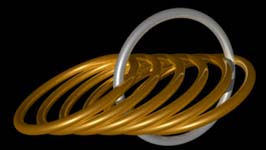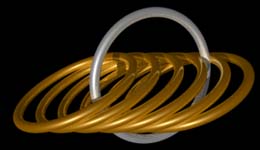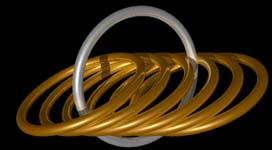
This is the beginning of the 1-down 5-up chain. To continue it, you would simply stick a closed ring on an open ring and then pass the open ring through the five rightmost copper rings, from below. It's like weaving HP 3-1, except denser. The finished chain would look something like this:

This weave has a drastically emphasized V-shaped cross-section, which might conceivably be useful for wrapping jobs, although I would personally use EPH or a three-fourths Persian weave. Alternatively, you could just make it because you like how it looks, but if you think this form looks nice, you should check out the 2-4 version:

Again, this is the start of the 2-down 4-up form. It's like HP 4-1 in that you go down through one ring, then add a closed ring, then go up through the rest of the rings. However, in this case, the "going up through" part is through four rings instead of 2. Hence the name. The V-shaped cross-section is less pronounced in this form:

However, both of the above chains do have V cross-sections. Remember that traditional HP 4-1 has a rectangular or X-shaped cross-section; can we replicate that in HP 6-1? Obviously, or I wouldn't be talking about it. The 3-down 3-up form of HP 6-1 has the same type of cross-section as HP 4-1, being merely a heck of a lot more dense.

This is the start of the 3-3 split form. You'd have to go down through two rings, then add a ring, then up through three rings to lengthen the chain. Notice how the closed ring in that step takes the form of a "down" ring. That's just because of the orientation we're using when we weave; if we made it an "up" ring, then we'd also have to reverse the weave (in which case it would be a 3-up 3-down chain instead of a 3-down 3-up chain). In any event, longer chains look a bit like this:

So now you've seen the three versions of HP 6-1 that exist (this is discounting the sheet forms!). However, you can extend this theory to any level of Half-Persian chain. With these techniques, you can make an HP 4-1 with a V-shaped cross-section. You could aos, though I don't know why you'd want to, make 5 different HP 10-1 weaves and string them all together. In any event, now you know. Enjoy!
Go backAll items on this site are copyright 2003 Chris Weisiger (a.k.a. Derakon). That's right - I made everything on this site. Reproduction of any of my work i\ n whole or in part requires my express consent.